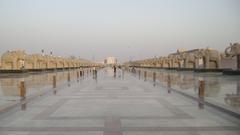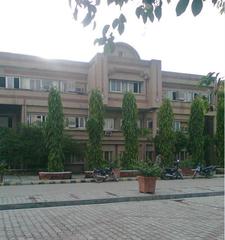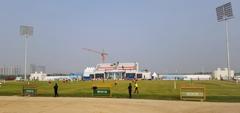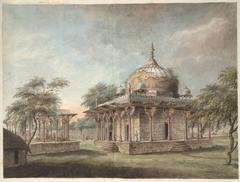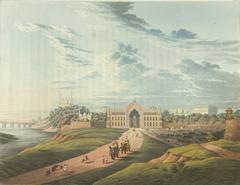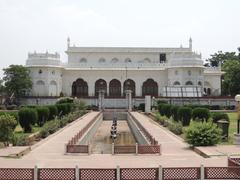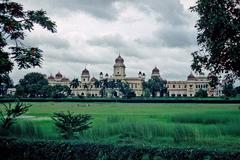
Qaisar Bagh Lucknow: Visiting Hours, Tickets, and Historical Significance
Date: 04/07/2025
Introduction to Qaisar Bagh Lucknow
Qaisar Bagh, situated at the heart of Lucknow, is a magnificent symbol of the city’s Nawabi heritage and architectural brilliance. Commissioned by Nawab Wajid Ali Shah between 1847 and 1852, this sprawling palace complex was conceived as an imperial garden and royal residence. It showcases a blend of Persian, Mughal, and European architectural styles, highlighted by its charbagh gardens, Baradari pavilion, and intricately decorated zenana quarters. Beyond its architectural beauty, Qaisar Bagh was a vibrant center for the arts, fostering classical dance, music, poetry, and the unique “Lucknowi Tehzeeb”—a culture of refined manners and inclusivity.
Qaisar Bagh’s historical significance is amplified by its role during the Indian Rebellion of 1857, where it served as a rebel stronghold and witnessed pivotal moments that marked the end of the Nawabi era. Today, the palace complex remains a must-visit for those seeking to immerse themselves in Lucknow’s layered history. With accessible visiting hours, free entry, and proximity to other heritage landmarks such as Bara Imambara and Rumi Darwaza, Qaisar Bagh stands as a testament to Lucknow’s enduring cultural legacy (Lucknow Tourism, Outlook Traveller, Tour My India).
Table of Contents
- Historical Background
- Visiting Qaisar Bagh
- Frequently Asked Questions (FAQ)
- Conclusion and Visitor Summary
- Sources and Further Reading
Historical Background
Origins and Construction
The term “Qaisar Bagh” means “Emperor’s Garden,” a fitting name for a complex designed to dazzle both subjects and foreign visitors. Built under the patronage of Nawab Wajid Ali Shah, the last Nawab of Awadh, Qaisar Bagh was intended as a statement of opulence and grandeur. The palace complex features a hierarchy of interconnected courtyards and gardens, symbolizing the Nawab’s authority and refined taste (Tour My India).
Architectural Design and Influences
Qaisar Bagh is renowned for its harmonious blend of architectural styles:
- Persian and Mughal Traditions: The charbagh layout mirrors the four-part gardens found in classic Persian and Mughal palace designs, symbolizing paradise and tranquility.
- European and Moorish Elements: Features such as Ionic columns, Moorish minarets, and neoclassical pediments reflect the western influences embraced by Lucknow’s elite in the 19th century.
- Nawabi Innovations: The complex includes yellow-painted zenana quarters, ornate banisters, and balustrades, all contributing to the unique Nawabi aesthetic (Hotel Dekho, Yometro).
Key structures include the central Baradari—a white marble pavilion serving as the focal point for royal gatherings—and the Safed Baradari, which was both a ceremonial hall and a venue for cultural events.
Role in the 1857 Uprising
Qaisar Bagh’s historical importance is closely tied to the events of the Indian Rebellion of 1857. After Awadh’s annexation by the British East India Company in 1856, the palace became a center of resistance. During the siege of Lucknow, Qaisar Bagh was stormed by British forces, leading to the looting of treasures and the repurposing of its buildings for military use. Although much of the original complex was damaged or destroyed during this period, the surviving structures continue to embody the resilience and cultural pride of Lucknow (Outlook Traveller).
Cultural and Artistic Legacy
Qaisar Bagh was not merely a royal residence, but also the epicenter of Lucknow’s cultural renaissance. Nawab Wajid Ali Shah was a famed patron of the arts, supporting classical dance (notably Kathak), poetry, and music. The palace is particularly associated with the tawaifs—accomplished courtesans who were integral to the cultural and social life of the era. Their legacy is preserved in Lucknow’s music, dance, and etiquette (Lucknow District Official Site, Scribd: Cultural Impact of Tourism in Lucknow).
Visiting Qaisar Bagh
Opening Hours and Entry Fees
- Opening Hours: 8:00 AM to 8:00 PM, daily (Holidify).
- Entry Fee: Free of charge for all visitors.
- Photography: Permitted in outdoor areas; professional shoots require prior permission.
Tip: Visit during the cooler months (October to February) for a comfortable experience. Early mornings and late afternoons offer the best lighting for photography.
Facilities and Accessibility
- Restrooms: Available near the main entrance.
- Seating: Benches and shaded areas are located throughout the gardens.
- Wheelchair Access: Main paved pathways are wheelchair-friendly, though some older structures have steps or uneven surfaces.
- Food and Refreshments: No cafes inside; nearby local eateries provide authentic Lucknowi cuisine (Holidify).
How to Reach Qaisar Bagh
- By Air: Chaudhary Charan Singh International Airport is approximately 14–15 km from Qaisar Bagh.
- By Train: Lucknow Junction is about 3.5–5 km away; other nearby stations include Gomtinagar and Badshahnagar.
- By Road: Accessible via taxi, auto-rickshaw, app-based cabs, and public buses. Limited parking is available near the entrance (Optima Travels).
Travel Tips and Nearby Attractions
Combine your visit to Qaisar Bagh with other Lucknow highlights:
- Bara Imambara: A short drive away, renowned for its grand architecture.
- Rumi Darwaza: An iconic gateway close to the palace complex.
- Chattar Manzil: Noted for its European-influenced design.
- British Residency: Important for its role during the 1857 uprising.
Additional tips:
- Wear modest, comfortable clothing.
- Bring water and sun protection.
- Hiring a local guide is recommended for detailed historical insights.
- Respect the heritage structures and avoid littering.
Frequently Asked Questions (FAQ)
Q: What are Qaisar Bagh’s opening hours?
A: 8:00 AM to 8:00 PM every day.
Q: Is there an entry fee?
A: No, entry to Qaisar Bagh is free.
Q: Are guided tours available?
A: Yes, local guides can be hired at the site for a more informative experience.
Q: Is the complex wheelchair accessible?
A: Major pathways are accessible, though some structures may have steps or uneven surfaces.
Q: Where can I park my vehicle?
A: Limited parking is available near the main entrance. Early arrival is advised.
Q: Is photography allowed?
A: Yes, in outdoor areas. Professional shoots require permission.
Conclusion and Visitor Summary
Qaisar Bagh is an enduring symbol of Lucknow’s royal grandeur, artistic heritage, and historical resilience. Its architectural fusion of Mughal, Persian, and European styles—exemplified by the Baradari pavilion and zenana quarters—offers visitors a vivid glimpse into 19th-century courtly life. The palace’s association with the 1857 uprising further cements its place in India’s historical narrative.
With daily visiting hours from 8:00 AM to 8:00 PM and free entry, Qaisar Bagh is accessible to all travelers. Its central location makes it an excellent starting point for exploring other Lucknow landmarks. Guided tours, cultural events, and ongoing preservation efforts ensure that visitors enjoy a rich and immersive experience. Utilize resources such as virtual tours, local guides, and travel apps like Audiala for a seamless journey through this iconic heritage site.
For further reading and virtual exploration, refer to the sources below.
Sources and Further Reading
- Official Lucknow Tourism Website
- Outlook Traveller: Lost Legacies - Discovering Lucknow’s Tawaif Heritage
- Tour My India: Kaiserbagh Palace, Lucknow
- Holidify: Kaiserbagh Palace Sightseeing
- Optima Travels: Kaisar Bagh, Lucknow
- Hotel Dekho: Kaiserbagh Palace in Lucknow
- Lucknow District Official Site: Culture & Heritage
- Scribd: Cultural Impact of Tourism in Lucknow
- Yometro: List of Monuments in Lucknow
- Times of India: Kaiserbagh Palace Complex
We invite you to step into the legacy of Qaisar Bagh—where history, art, and culture converge in the heart of Lucknow.





























